Another Klotski puzzle
This week: Sunday therapy; Digging in; Another Klotski puzzle;

Parcels have been arriving almost every day this week. Some tools have arrived, a book and also various parts for the new computer.
However I am still waiting for some crucial cables and computer parts before I can start building work.
The weather has been very kind as well, so as much time as possible has been spent outside.
I was also gifted an Avocado tree this week by friends.

For now, this will remain in its pot in the polytunnel. Then next spring I will plant it out into its permanent home.
I have started picking the Persimmon fruit this week. They are smaller than in previous years, however that has not affected their sweetness or taste.

We had some much needed rain early on Saturday morning which curtailed garden work because it left everything damp.
However I am not short of jobs, so I did more work on the flu for the wood stove. As the clocks change next weekend, we are drawing ever closer to the time when I will need to think about using the central heating….
Sunday therapy
Sunday’s are slower days and last weekend was no exception. They are still a “quiet day” here too.
The sun was hot, there was little wind so I took the opportunity to work outside.
I had found an empty Computer tower unit and decided that it would be ideal for my new desktop system. Except is is actually a tower and will sit under my desk rather than on top of it!

I realised that I should give it a good clean because it was very dusty. I took it out onto the terrace where I could waft dust around without concern and work in the warm sun.
The first job was to undo everything and reduce it to a bare chassis.
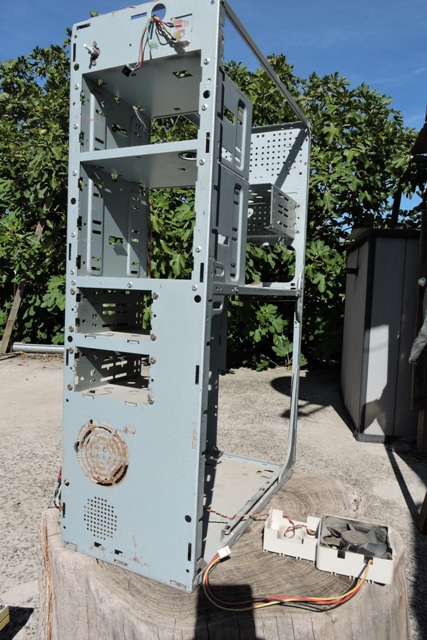
This makes cleaning much easier. However I discovered when I removed the front cover that the steel chassis had corroded slightly around the fan port.
This is no doubt due to air humidity condensing on the cool steel as it was being drawn in by the fan.
You need good air circulation inside a computer to keep things cool. The downside is that air being drawn in contains dust and so you get dust and debris inside.
I set mine up so that air is drawn in at the top of the case and expelled at the bottom. This means that I have positive pressure inside the case. Even so, there was some dust in the corners.
What I did find was the makers stamp which showed a build in early 1999. I have a vague recollection of buying it at a computer fair in Hull in 1999. So it has been used in at least three and possibly four countries, travelling around the world as I have moved for the last 26 years.
Once all the various chassis components were removed, it was easy to brush the dust out.
I decided that while I was down to the bare chassis, it would be easy and prudent to sand down the corrosion and then spray paint the metal work with a rust inhibitor.
Using some emery paper, I was soon down to clean, bare metal. I gave everything a coat of grey undercoat and rust inhibitor. It was almost the same colour as the chassis had been painted originally.
I left everything out in the sun to thoroughly dry.
As soon as more of the components I have ordered arrive, I will be ready to start construction.
There is a modern trend of having all kinds of LED lights actually inside a transparent computer case. This is usually in gaming computers.

For my system, no one is likely to see the insides and although the motherboard I have ordered does have LED lights, I’m not going to turn them on.
Digging in
With fine, warm weather all week I have spent as much time as possible in the Top Orchard, moving soil.
My aim at the start of the week was to completely level the area where the bog garden will go. I also wanted to move the soil fill up the border at the end of the orchard.
The “moving” is the easy bit, it has been the preparation which is taking the time.
I had moved the rotary riddle last week so all it needed was to run the extension lead to provide power.
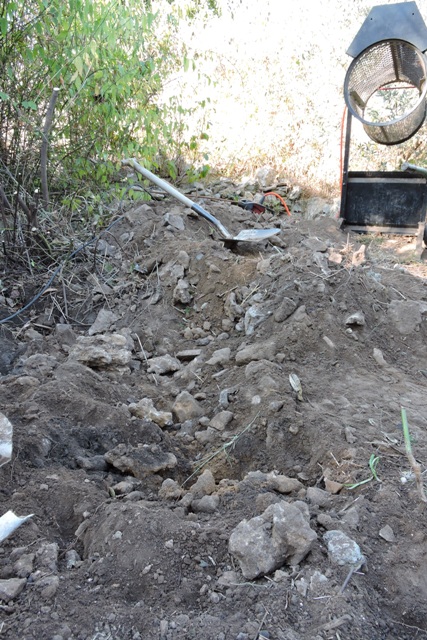
Trying to dig out the shovel’s of soil was difficult because of all the stones. I was told years ago by a local friend that they seldom use shovels because of stone. Instead of a shovel, locals use a mattock and steel bucket to move soil.
I used the mini digger to break up the soil and also moved stones by hand. Once that was done, I could then shovel the spoil into the rotary riddler and move it in a wheelbarrow to back-fill the herbaceous border.

By trial and error, I found that a garden rake was an easy tool to pull out stones before digging.
My rule of thumb for the stone to soil volume has always been that I have about ⅓ stone to ⅔ soil by volume.
After this week’s exercise, I am revising that to ⅜ stone to ⅝ soil. In places it is as much as half and half.
The riddle is doing a good job of removing stones, but the volume of soil I have left over to fill the border is not as much as I was expecting.

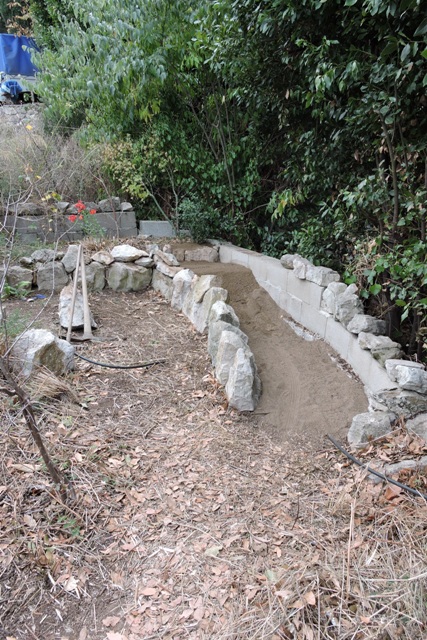
Revising the plans – Another Klotski puzzle
By Thursday afternoon I had finished levelling the area where there was the spoil heap. However I had barely filled half the new herbaceous border.
In addition, as I dug down into the newly flattened area, I realised that I was down to bedrock. I know my soil depth is not very thick, but this was ridiculously shallow.
My plan had been to excavate down to subsoil level and then lay a membrane which I would cover with riddled soil. This would become the bog garden.
Two things are now preventing this. First I have a huge amount of stone which I am going to have to dispose of somewhere. Secondly there is not enough top soil for what I was planning.
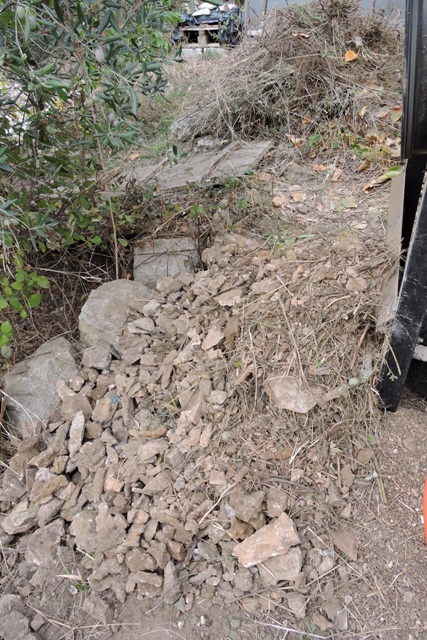
Quite simply, I had not appreciated how thin the soil layer was and just how much stone there is within it.
This is another of my “Klotski” puzzles. I have no history for this 200 square metre plot’s history. All I know is what I found when I moved here.

There were once olive trees here, but by the time I bought the property, all but one were dead stumps. There were two mature plum trees and I also found a mound of spoil. This was a metre above the level of the surrounding orchard.
In an effort to level everything, this mound was spread. I built a retaining wall to hold it, so an area of some 32 square metres, 6 metres east to west and 5.2 metres north to south was “somewhat” level.
I suspect that the mound of spoil and all the stones it contains, is the result of the septic tank immediately on my neighbours side of the boundary being excavated many years ago.
Over time I have planted cherry and plum trees, table olives and cob nut trees, persimmon and Nashi pears all around.
This means that I now have limited space where I can work. The puzzle is how to use the ‘free’ square effectively, so I can excavate, remove stones, move soil and then make the area level and usable.
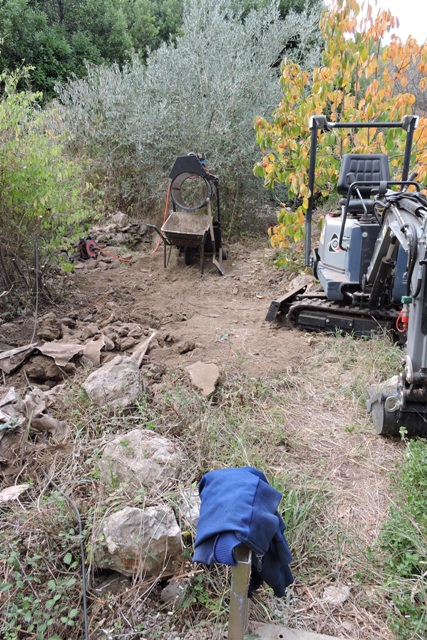
My plan for this week had been to riddle all the soil, levelling the whole area and using the soil in the herbaceous border. I have done that, however I am left with a couple of problems.
First is the sheer volume of stones which has come out and also I am short of soil, by some 10 wheelbarrow loads.
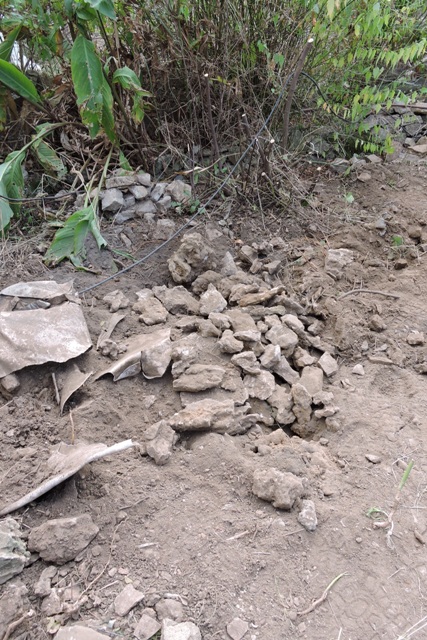
On Friday I backfilled an exploratory hole I had dug, looking for useable soil, with the largest stones. On top I put the small stones and levelled them.
Then I laid some old linoleum on top of everything to keep the stones and any soil separate.
I have a plan of how this area will look when it is finished, which includes an all weather path, using the riddled stones.
My revised plan is now to dig out where the path will go and use that soil to finish the herbaceous border.
Then I will dig out a corner which I had planned to leave, riddle the soil and replace it behind a retaining rockery wall, with the riddled stone being used for the path.
All this is starting at the western end of this plot, moving machines and materials steadily east (to where the access of the orchard is) so that when it is all finished, I can get the machine out.
With rain being forecast from Tuesday next week, I have two and a half days to finish the herbaceous border and do whatever else I have time for.
It does mean that the bog garden may well be an over-winter project. NCG